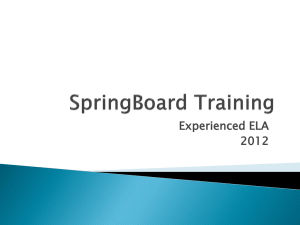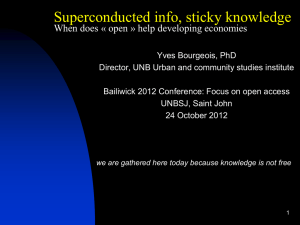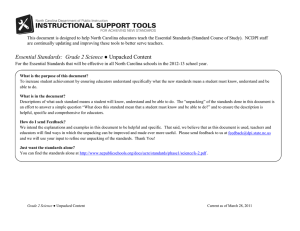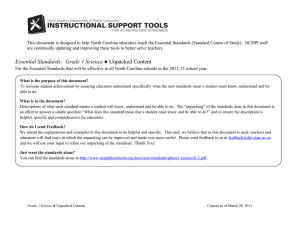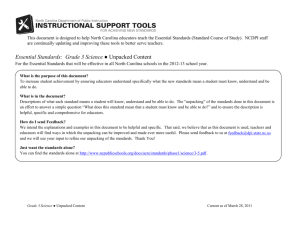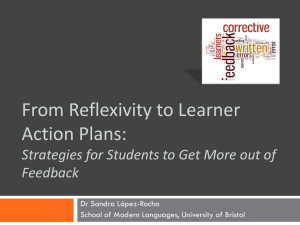HS Experienced Teacher Training Day 1
advertisement
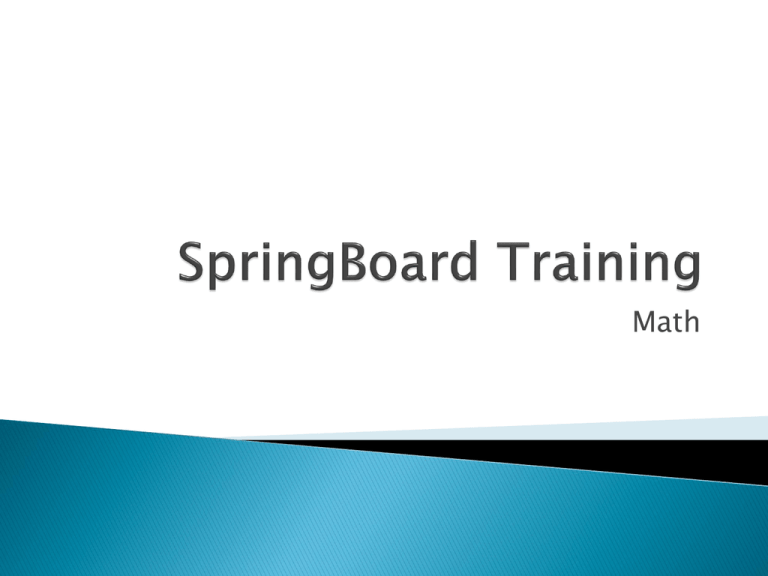
Math Unpacking Embedded Assessments “To begin with the end in mind means to know where you’re going before you get started so that every step you take is always in the right direction.” Stephen Covey, author of The Seven Habits of Highly Effective People, as cited in Understanding by Design, by Grant Wiggins and Jay McTighe Initial Institute Workshop Where are we headed? Individual Accountability: Read the assignment and in the text, mark what you will have to do. Scoring Criteria Content Assessment Vocabulary Cognitive Engagement Collaboration Differentiation Formative Assessment Exemplary Participants are required to use sustained critical and creative thinking as a result of a well-developed lesson design and insightful activities. The overall purpose of the lesson and its connection to the Embedded Assessment are clearly shared with the participants, fostering an understanding of the relationship between both. Critical vocabulary is highly visible and aligned to the instruction. Additions of comments/notes help participants connect learning to the assessment while fostering an innate sense of ownership through participant-generated materials. Proficient Emerging The lesson and activities are designed so that The lesson and activities are insufficient participants are required to use critical and by design, requiring participants to use creative thinking. limited critical and/or creative thinking. The overall purpose of the lesson is The overall purpose of the lesson and its underdeveloped and/ or unfocused. Its connection to the Embedded Assessment are connection to the Embedded Assessment shared with the participants. is not shared or is unclear to the participants. Critical vocabulary is visible and aligned to the instruction. Additions of participantgenerated materials /notes help participants connect learning to the assessment. Critical vocabulary is not visible and/or aligned to the instruction. Little or no additions of participant- generated materials /notes are visible. Activities show little or no variety in design and lack sufficient development to move participants to a greater level of cognition. Discussions are unstructured or The lesson is designed to facilitate discussion discouraged. around the work and allow participants to Participants are expected to approach to experience different approaches to the same the same task with little or no variance. task. Independent think time is minimal. Independent think time is allowed and Many participants are disengaged as participants bring their own product/idea to lesson does not have individual the group based on their role/lesson expectations which culminate into a expectation. group product. Activities are purposefully designed to move Activities are designed to move participants participants strategically through multiple through multiple levels of cognition. levels of cognition. The lesson is designed to facilitate productive discussion around the work, foster increased understanding, and allow participants to experience different approaches to the same task. Independent think time is critical, allowing participants to bring their own product/idea to the group based on their role/lesson expectation. Uses a variety of strategies, process and/or products as a way of facilitating participants’ understanding. Following multiple formative assessments, strategic adjustments are made during the lesson to provide additional support for learners. Uses a variety of strategies as a way of facilitating participants’ understanding. Lacks a variety of strategies thereby minimizing participants’ understanding. Following formative assessments, some adjustments are made during the lesson to provide additional support for learners. Adjustments and formative assessments are inconsistent or non-existent during the lesson, providing no/little additional support for learners. • Divide your paper into 3 sections. At the top of the first section write green, the next yellow, and the last red. • For each of the 7 indicators, determine your current level of implementation and write the indicator in that section of your paper. Red- The EMERGING criteria best align with my practice Yellow- The PROFICIENT criteria best align with my practice Green- The EXEMPLARY criteria best align with my practice Target: To describe the conditions key to effective student collaboration and consider methods to employ these in my classroom. Individually: What are the key components of effective collaboration? Think- Write- Group- Share VIDEO Setting things up • • • • • Expectations/Norms Physical set up Roles Clarifying learning intentions and criteria for success Consistent Cues Strategic grouping • Things to consider when assigning groups • Purpose of collaboration Ensuring group and individual accountability • • • • • Providing feedback to move learners forward Activating students as owners of their learning Activating students as instructional resources for one another Engineering classroom discussion Strategies to encourage collaboration Issue: Things to consider: My students work independently even Roles (with accountability as you circulate) when I tell them to work as a group. Physical set up of room Have each group create a single product (poster, paper, presentation) and time to share (gallery walk, explain at board/document camera) Ask a random group member to summarize the group’s discussion for you as you circulate Instruct students to partner with someone in their group and decide whether you agree or disagree. Explain your partner’s viewpoint and why you agree or disagree to the other pair in your group. Come to a group consensus. Some of my students get off task and Each student create their own product from the group’s effort aren’t focused on content when they Choose a group randomly to present their solution/method/reasoning for a problem are in groups. Ask all students to work on something individually first so they have a product/idea to bring to the group. It takes too much time. Set expectations and routines which allow quick transitions to and from small group to full class How do I know who gets it and who is just getting answers from the group. Some things just need to be done independently Formatively assess students individually (thumbs up, thumbs down, individual exit slips, display individual responses on whiteboards before collaborating Before each activity consider whether student discussion around their work will deepen understanding. Most often, collaboration allows students to identify and address their own misconceptions while seeing different approaches to the same problem. For tasks which are more independent you could: Enforce “independent thinking time” before students come together to share. (Don’t forget the THINK in think, pair, share) Ask all students to work on something individually first so they have a product/idea to bring to the group. If you are circulating and get the sense that most groups have the same question, “pause” the class for full class clarification It is difficult to get around to groups and answer the SAME question at every group. Even when I group students, they still call me over to answer EVERY question so what is the point. When you approach a group with a question, make YOUR first question to them- “Did you ask your group?” This will reinforce the expectation that they turn to each other first. Effective feedback through questioning rather than statements will encourage students to try to figure things out before they ask because they know you aren’t going to give them the answer. Ask students in a group if they agree or disagree with each other and why. Students will have to discuss with each other in order to be able to do this. Recorder Role: Compiles group members’ ideas on collaborative group response Sound Bites: “I think I heard you say _______, is that right?” “How would you like me to write this?” Reader Role: Reads the prompt aloud to the group and leads the group in analyzing what the group is being asked to do Sound Bites “What do you think this is asking us to do?” “Did we answer the question that we were asked?” Reporter Questioner Role: Presents the ideas of the group to the rest of the class Sound Bites: “I am hearing two different ideas, which one do we think is right?” “How would you like me to present our ideas to the class?” Role: Asks each group member to consider questions raised by other group members. This is the only person who may determine that the group needs to ask the teacher. Sound Bites: “_________ has a question. Does anyone know the answer to that?” “Do you guys agree with _____’s idea?” Reflection: On a post-it write one thing discussed in this session which you will consider trying in your classroom. Post it on the Unpacked EA next to collaboration as you leave for break. Unpacking Embedded Assessments Interactive Word Walls Target: To choose an appropriate method to unpack an EA and make annotations to connect student learning to the EA. Delivering SpringBoard Lessons Unpacking Embedded Assessments “To begin with the end in mind means to know where you’re going before you get started so that every step you take is always in the right direction.” Stephen Covey, author of The Seven Habits of Highly Effective People, as cited in Understanding by Design, by Grant Wiggins and Jay McTighe Initial Institute Workshop Unpack each Embedded Assessment with each class before the group of lessons leading up to the EA. Students are active partners in unpacking the EA. Post the unpacked EA in the room and refer back and make notes on it during each lesson to help students connect learning to the assessment Use unpacking sessions to formatively assess students’ understanding and knowledge of a topic to inform pacing What words do students know/not know? What skills do they think they already have? How did the choice of methods impact students? What changes to this (if any) would you make in your classroom? What should be taken into consideration when choosing a method for unpacking an EA? How might this impact student learning during the unit? Use the following roles while unpacking: Recorder- Writer Questioner/Runner- Speaks to trainer/posts visuals Reporter- Speaker Reader- Anything aloud in small/large group. Your unpacked EA (your choice of method)? How does your choice of method support student understanding? How does each lesson connect back to the EA? Add this to your unpacked EA as you show us. Reflection: What is the purpose of unpacking Embedded Assessments with students? 3 words max on a Post-it note Target: To design vocabulary instruction which emphasizes multiple representations and relationships between words. In the book Classroom instruction that Works, Robert Marzano states: Some researchers have concluded that systematic vocabulary instruction is one of the most important instructional interventions that teachers can use, particularly with low-achieving students. Introduce vocabulary words when they come up in a lesson Post STUDENT GENERATED work on the word wallit doesn’t need to be neat! Include multiple representations with the word Organize the words in a way which illustrates relationships between words Choose 5-15 words from the lessons that students would or should identify as word wall items What representations for each word could you encourage students to include? How could you arrange these words to emphasize the relationships between them? Reflection: How will this create a sense of ownership among students? What was your biggest take away from this session? Think- Group- Share Chart Target: To identify the key principles of differentiation and apply them within the instructional framework of SB. Using the Differentiated Planning Guide Each course level choose a lesson that you would like to focus on to differentiate: Algebra I Geometry Algebra II Differentiated Instruction Individual accountability: Using your student scenario, brainstorm on paper how you would differentiate for this student through product, process or content during the chosen lesson. Differentiated Instruction Group accountability: Join others that share your same student. Discuss how you would differentiate content, product, or process for this student. Commit each reasonable idea to an individual Post-It. Recorder- Writer Runner- Speaks to trainer/posts visuals Reporter- Speaker Reader- Anything aloud in small/large group.
